How to Make Liquid Soap from a Solid Soap Bar, Take 2
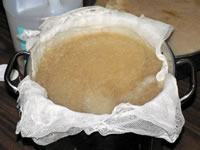 Three years ago, trying to find a way to have liquid soap without the plastic bottle, I discovered that you can’t actually make real liquid soap from a solid soap bar. What I ended up with was a slimy green failure. And the reason is that liquid and solid soaps have different chemistries. The lye used to make solid soap is sodium hydroxide; whereas, the lye used to make liquid soap is potassium hydroxide. According to Wikipedia:
Three years ago, trying to find a way to have liquid soap without the plastic bottle, I discovered that you can’t actually make real liquid soap from a solid soap bar. What I ended up with was a slimy green failure. And the reason is that liquid and solid soaps have different chemistries. The lye used to make solid soap is sodium hydroxide; whereas, the lye used to make liquid soap is potassium hydroxide. According to Wikipedia:
The saponification of fats with KOH [potassium hydroxide] is used to prepare the corresponding “potassium soaps”, which are softer than the more common sodium hydroxide-derived soaps. Because of their softness and greater solubility, potassium soaps require less water to liquefy, and can thus contain more cleaning agent than liquefied sodium soaps
So for the past 4 years, I’ve been doing without any kind of liquid soap. But recently, attempting to deal with some fungus problems in my garden, I’ve come across several recipes for treatments that require liquid dish soap, and not having any, I decided to try once again to make liquid soap out of solid soap. I found some actual instructions on the Internet for doing just that, and I realized there were a few mistakes I made the first time around. Â The ratio of soap to water was way off, and my method of dissolving the soap was just insane. I also think I chose the wrong kind of bar soap to start out with.
You Can (Sort of) Make Liquid Soap From Bar Soap
For what it’s worth, here are the best instructions I can come up with for making a pseudo liquid soap out of bar soap. It’s not perfect. The end result is slimier than real liquid soap, but it works for my purposes and maybe would work for you as well.
Ingredients: 4 ounces of solid natural soap, 1 gallon of water, cheese grater, big steel pot, and an electric mixer (not essential but helps.)
Look at the proportion of soap to water. In my previous attempt, I dissolved an entire 1,000 gram block of solid olive oil soap in a pot of water. That’s about 9 times as much soap as I should have used. No wonder I ended up with a pot of solid soap after the mixture cooled.
This time, I chose a 3.55 ounce bar of Sappo Hill aloe vera soap made with palm oil, coconut oil, and glycerin. I thought maybe these ingredients would make a smoother, less slimy liquid soap than the olive oil had. Also, it’s what I had in the house. Sappo Hill soaps are sold naked without packaging — plastic or otherwise.
(I also reduced the water by 25% since I used less than 4 ounces of soap.)
1) Grate the solid soap. This is an important step to a well-mixed result. The last time, I just stuck the whole block of soap in a pot of water on the stove and waited forever for it to dissolve.
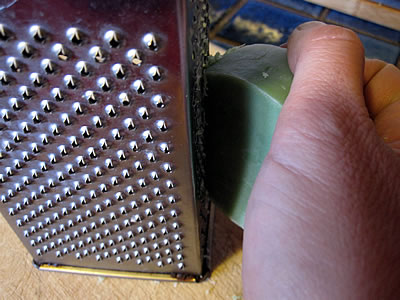
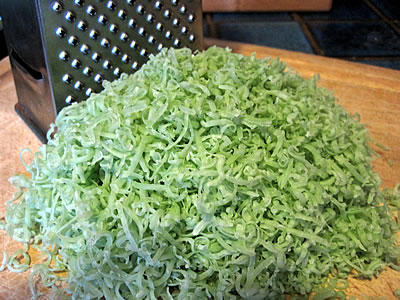
2) Bring water to a boil in steel pot and remove from stove. Pour grated soap into pot and stir until dissolved.
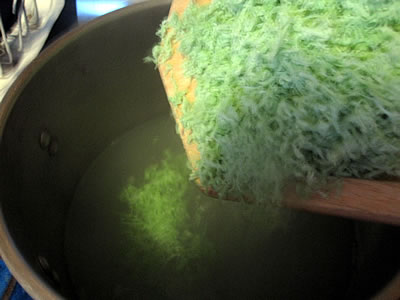
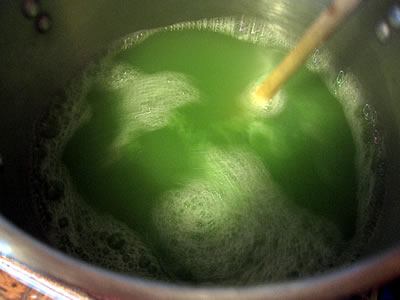
3) Let sit over night.
The next day, the soap had somewhat solidified into a thick jelly. It was kind of slimy, but definitely not solid. I could have stopped at this point and used it as is.


4) Blend with a hand mixer.
This step ensures the soap is mixed well but it also adds air to fluff it up and make it less like something that came out of your nose the last time you had the flu.
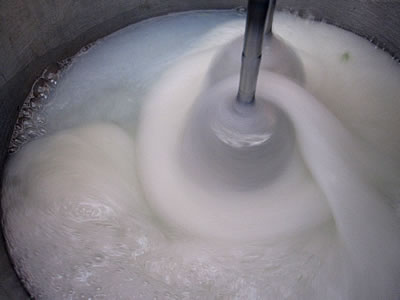
The result is quite nice, if not exactly Dr. Bronner’s.

5) Bottle it in a glass jug or a secondhand pump bottle.
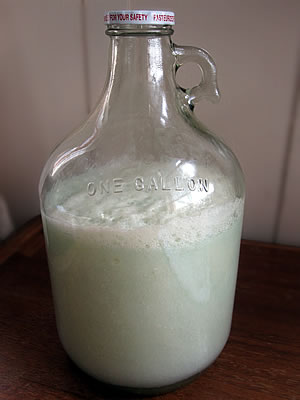
Do keep in mind, per the Wikipedia entry above, that this soap is less concentrated than real liquid soap, so when using it in recipes, you will probably have to use more than is called for.









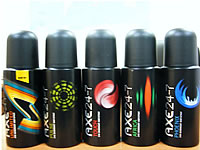

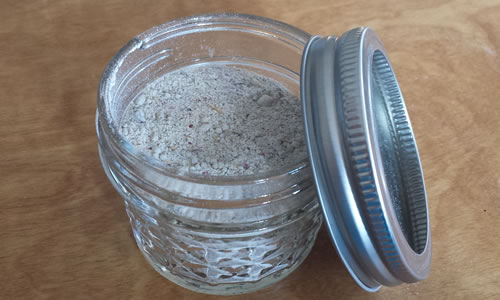
Hi! I know this post is old but I just came across it, as I’ve been trying to do the same. I just wanted to know-did the soap stay at the consistency it was after blending? Or did it revert back to a block after a while? Thanks!
It stays liquid, but you do have to shake it to keep it mixed up. It’s not “real” liquid soap but it works.
My liquid soap gets solid after the temperature down. How do you manage to keep it in liquid phase? It becomes bigger bar soap and stuck on the jar.
Did this end up as a jelly again the next day? That has been my problem with bar soap to liquid recipes. I blend and store after it cools overnight and then end up having to toss it because I can’t get it out of the stored jar.
Yeah plastic free life is fine, but how much energy went into doing all that?
You can’t really live now days plastic free. The dish rack.. it’s coated in plastic.
The refrigerator’s innards… plastic. Lots of plastic in you vehicle, got carpet in the house? The TV, radio, flash light, trash bags, and oh that computer…lots of plastic!
Don’t get me wrong I’m not trying to rain on your lifestyle, I’m just observing the missed points.
The fact that we buy one-time use plastics all the time, when there are easy to find glass or paper alternatives, IS the point. Her reasoning is that she will have to discard some things, and since plastic takes decades to degrade, she buys what degrades faster, and/or healthier. Also, plastic hasn’t been around long enough to perfect it, better plastics are still being made, there are even “Bio†plastics out now. It may not change the world overnight, but still she has changed her world, and a persons actions do influence others.
Yay Lisa. I’m glad to know this worked out for you! I’ve included the recipe in my book, and it’s good to know that other people have had success with it.
Hey beth!
The soap was a success! I first tried making it and not using a hand mixer and it was too thick and gooey. And very slimey aswell. However i used a handmixer and really mixed it until it was entirely bubbly and had “stiff peaks” I then let it sit for some time until the bubbles started disappearing and then transfered it into my olive oil dispenser i use for dishsoap. It really works wonders, and i am really happy with the results! I will never go back to liquid dish soap again.. So just a tip for all you readers, if the soap is too gooey really mix it properly and make it very frothy and it will then have a better consistency.
Thanks a lot Lisa. Just last night I failed with solid soap again on my hand! The quantity of water was the point. I am trying it again lol. To let the bubbles disappear completely, they use ethanol alcohol spray. Just one spray, they disappear. I will let you know with my result soon.
I just found this recipe for liquid soap via Pinterest – has anyone tried adding glycerine?
http://www.savvyhousekeeping.com/how-to-turn-a-bar-of-soap-into-liquid-hand-soap/
Hi Desiree. I did see that recipe a while back and forgot to mention it, so thanks for the link. I didn’t add glycerin because the soap I used, Sappo Hill, already has extra glycerin added to it. But I think if you use a soap without added glycerin, it might be nice to add. The only thing about glycerin is that it’s not always easy to find it in glass. All the regular stores around here sell it in plastic bottles. I did find one local herb shop that sells vegetable glycerin in glass, but it took quite a bit of searching.
Actually glycerin is another name for glycerol which is a non-toxic pure organic chemical compound HOCH2-CH(OH)-CH2OH. Anything sold as “vegetable glycerin is a con.
I would love to know how to make a liquid soap that does not cause castile/soap reside to remain behind on the hand. Maybe it’s my hard water…but I do have water filters…though I’m not sure if they help much with the hardness. GREAT post!
Also, mason jars (Ball/Kerr) now sell some of their jars as “freezer safe” in grocery stores. Very affordable. And while it’s better to find them second hand to avoid any plastic packaging, I wonder how we can “tell” which second hand jars are also freezer safe? Certain sizes? Certain batches? Certain years? I love the 16oz wide-mouthed size for just about everything–drinking glass, refrigerator storage, easy cleaning, easy stacking, etc.
Don’t get me wrong… buying in bulk is always better than buying individual bottles, and it is true that Dr. Bronner’s bottles are made from recycled plastic. That’s all great. I just wish there were a way to send back those gallon jugs to be refilled. The last time I checked, they didn’t take them back.
At my local store the bulk soap is in 5-gallon dispensers. According to the Dr Bronner’s website they are made of 100% post-consumer plastic, but I’ll have to ask what they do with them when they’re empty. It’s definitely a better option than tons of tiny virgin plastic bottles, but thanks for giving me another aspect to think about.
Betsy, you can buy it in bulk usually but the bulk liquid soap still comes in a plastic jug. It’s a matter of cutting down on plastic packaging vs. eliminating it. But read some of the comments… there are apparently easier ways than what I did. Also? What I did was not hard at all. Seriously.
Wow, this looks like too much work for me. I would just use bar soap but my husband insists on liquid. Wish I could buy it in bulk somewhere…
Thanks for the great frozen glass tip-love the photo of your jars all stacked and nice and frozen-I have lots and lots of lovely old jam jars which I have saved up over the years-frozen glass here we go! I do love those glass containers with the stainless steel lids-amazing idea-wish our local supermarket had them-maybe someday in the future they will! Do you find that the glass holds out well from repeated freezing and thawing?
Best Wishes
so easy to do.
I made some last night
thx 4 the directions
very interesting-I will be trying my luck with some blue laundry soap-I’m don’t mind grating-it’s hard work but not that hard-you mentioned that you freeze cheese in jars? How does that work out-I’m all out of ideas about how to freeze stuff without bags-at the moment i just reuse the same bags, but I freeze a lot of beans and chick peas etc ?
I freeze a lot of beans and chickpeas too. In glass jars. It’s not a problem. Don’t fill them up all the way. And don’t heat the jars after taking out of the freezer. You can also use containers like these for freezing, but they cost money:
http://myplasticfreelife.com/2011/06/airtight-glass-food-storage-containers-review-giveaway/
Beth,
I had the very same issues when I started making my own liquid laundry soap!
Over time, I have decreased the bar soap portion to other ingredients. And i increased the water content as well.
I reuse my white vinegar bottles for my homemade laundry detergent over and over…
The best part, for about 1/2 hour of my time about every 3 months, I save about $80.00 !!!
Great blog post, Beth, we are always learning in this “school of Life” :)
I have been buying the same bulk liquid soap (hard plastic or plastic bag-type containers) as most people do thinking ‘it’s better than the small containers over and over again. I’m almost out of stock, I hope to try it soon, thanks so much for the post!
My mother has made liquid soap for years out of the ends of bar soap — you know, the slivers that break in your hand. She grates or chops it, puts it in a large saucepan with a lot of water and boils it up. She says when it gets thick, she adds more water and then more water. She says at the ends she adds “some” rubbing alcohol to smooth it out and that the alcohol evaporates. She doesn’t bother with a mixer or food processor, just a wooden spoon and a copper-bottomed stainless steel pot. We also mix soap ends with water in a container like a toilet brush container and use that and the brush to scrub rings from the bathtub.
The last time I scrubbed my tub, I used baking soda and broom. It was my old, frizzy broom and saved me a lot of bending. Just be careful not to scratch surface with whatever holds the broom’s straws (?) together.
I make my own laundry detergent and the first few steps are similar to what you have here. Grate soap, heat in a little water with borax and washing soda until all is dissolved. Stir and pour into a repurposed bottle, then top off with tap water. Cleans whites better than store-bought detergent!
I like Sappo Hill soap, too, especially the aloe & oatmeal one.
I started making my own lye soap a few months ago and this is almost exactly the same process I use to make my own laundry soap from my bar soap. I absolutely love making the lye soap and I highly doubt I will ever go back to soap from the store.
I use my food processor to grate the soap, too, and grate more than I need for one big batch of liquid soap. Remember, you don’t need to heat the water, just leave the grated soap in the water for a few days.
I also grate soap to make laundry detergent and usually grate a bunch of extra and store it until I need it next time so I can skip that step. Not a bad idea for making the liquid soap process faster too.
One of local health food stores sells Dr. Bronner’s in bulk, so I can take my own containers and fill them. Is that not available near you, or did I miss some other reason you don’t want to do that?
Hi Sarah. The reason I don’t fill up with Dr. Bronners in bulk is because those gallon jugs are the largest size, and they are plastic, and Dr. Bronner’s does not take them back for recycling. So I’d rather avoid the plastic altogether.
wow, well done! I’d switched to using bars for our everyday use, but I’ve felt compelled to keep a bottle of liquid soap for when company comes. When I run out of the stuff, here’s where I’ll turn. thanks!
It’s far easier than that! I grate bits & pieces of the pure castile soap that I make & put them in a big pot of water and leave it alone. The soap melts in a matter of a couple/few days. I bottle this liquid soap & sell it (as well as bar soap) – never had a complaint. I use it for laundry as well as washing me!
BTW, I’m going to use my food processors grating blade to grate the soap because I’m lazy and impatient . . .
Well, Darris, you do what you have to do. :-) I just used mine to grate an entire wheel of cheese I bought to avoid plastic packaging. It’s now all grated up in jars in the freezer. One thing though, I don’t like that the food processor pitcher is made from plastic, most likely with BPA. Just don’t put anything hot in there.
Were you listening into my conversation with my husband two nights ago?? I told him that I was not going to buy anymore soap in plastic bottles. He came home from Trader Joe’s with another plastic bottle of liquid soap. I buy bar soap, he wants liquid soap. Now we’ll both be happy : )
Thanks so much for rebatching and reposting this recipe Beth!
I put a bar of Dr. Bronner’s in an old mayonnaise jar and let it sit for a few days. I was surprised how much it dissolved. I drained off some of the liquid into a reused pump bottle and topped it off with water for cleaning jobs. I put more water with the bar and let it continue doing its thing. That seems to work fine for my purposes (spraying the floor after cleaning up cat vomit or hairballs, typically). I don’t know if it would work for your purpose, but it certainly is less work.